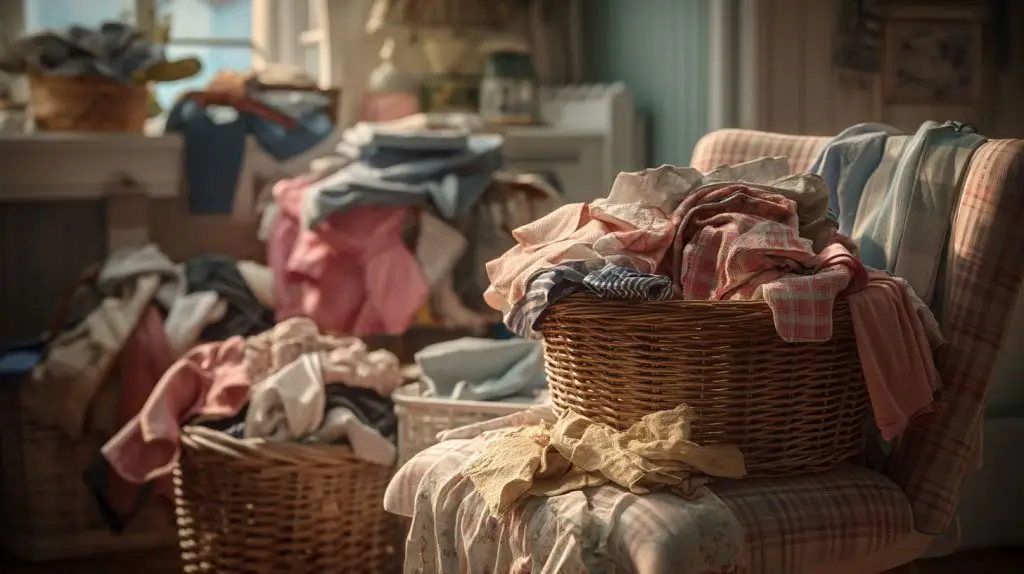
If you have a family, you don’t really do laundry. You survive it.
In Destin, between sports uniforms, beach towels that never fully dry, tiny socks that vanish in wormholes, and that one mysterious chair where clothes go to “rest” before being put away — laundry becomes less of a task and more of a lifestyle.
You can deep clean a bathroom and admire it for at least 24 hours. A kitchen can stay decent until the next meal.
But laundry? It respawns while you’re still folding the previous batch.
The family laundry cycle looks like this
- You gather all clothes
- You wash, dry, fold
- You turn around
- There’s already more
Repeat forever.
The real mess isn’t dirty clothes — it’s the system
Most families treat laundry like a reaction, not a system.
- Basket overflowing? Time to wash.
- No clean towels? Emergency mode.
- Kid needs the soccer shirt in 10 minutes? Tactical laundry strike.
This creates stress, piles, rushing, and resentment toward a machine that never asked for this lifestyle.
The most common laundry chaos zones in family homes
| Zone | What really happens there |
|---|---|
| Laundry basket | Overfills, then becomes a sorting archaeology project |
| Bathroom floor | Temporary towel storage, also known as “I’ll deal later” |
| Kids’ room | Clean and dirty clothes merge into hybrid piles |
| Dryer top | Socks awaiting reunion with their missing partners |
| The chair | Emotional support furniture for wardrobes |
The invisible side effects of laundry chaos
- The longer clothes sit, the more odors lock in
- Damp items hide in baskets and evolve into science projects
- Stains become permanent residents
- Folding gets delayed, which means wrinkles, which means ironing, which nobody enjoys
Laundry chaos isn’t just visual clutter. It creates time debt and emotional drag.
Why kids unintentionally make laundry 3x harder
Not because they’re messy — but because they live fully:
- Change outfits 2–3 times a day without announcing it
- Turn snacks into shirt art
- Treat towels like single-use paper
- Remove socks wherever their soul leaves their body
- Believe hampers are decorative furniture
And parents accidentally support the cycle
With good intentions:
- “I’ll fold it tonight” → becomes tomorrow
- “Put it in the basket” → child hears “near the basket”
- “We’ll sort together later” → never scheduled
- “I’ll do one quick load” → starts 5-load marathon
Laundry doesn’t need motivation — it needs mechanics
The key truth most families discover too late:
Laundry chaos is not a cleaning problem — it’s a logistics problem.
And logistics need structure, not hero moments.
What families think laundry success looks like
- Everything washed
- Everything folded
- Everything stored perfectly
- No piles exist
What real-life family laundry success actually looks like
- Nothing smells weird
- Everyone has what they need today
- The process doesn’t cause emotional damage
- The piles are managed, not mythical
The 3-Basket Strategy That Ends Laundry Avalanches
Most homes use one basket. That single basket eventually becomes a museum of regret.
The trick is switching to three smaller baskets instead:
- Fast turnaround basket — school clothes, work shirts, PE uniforms
- Priority but not urgent — everyday clothes, jeans, tops
- Slow lane — towels, bedding, beach gear
Why this works:
You always wash what you actually need first, not whatever happened to fall in first.
The 10-Minute Night Reset (The secret weapon)
Every night, spend 10 minutes doing this exact sequence:
- Move one load into the dryer
- Start one new wash
- Fold only one basket, not the whole house
- Put away or “half-put-away” (more on that next)
That’s it.
No heroism. No 2-hour folding therapy. Just rotation.
The No-Folding Folding Rule
The world divides into two kinds of people:
- Those who fold laundry peacefully like meditation
- Those who fold laundry like defusing a bomb under time pressure
If you’re type 2 (or you live with type 2), do this:
- Fold only visible layer clothes (shirts, pants, school outfits)
- Everything else gets the Clean but Chaos-Friendly System:
- Towels stack, don’t fold
- Socks live in one open bin (no pairing at folding time)
- Kids clothes get sorted by type, not folded by feng shui standards
- Pajamas roll like burritos and drop into a drawer
- Beach towels → hooks, not shelves
Neat-ish beats perfect every time.
The Sock Peace Treaty
Forget pairing socks at folding time.
Pair them when they’re needed.
One shared sock bin = peace, freedom, and 3 fewer mental breakdowns per month.
How to involve kids without starting negotiations
Don’t give kids the job of folding laundry — give them the job of sorting by ownership:
- “This is yours”
- “This is mine”
- “This is sibling property”
It becomes less of a chore and more of a territory claim.
The smartest wash order for family homes
Not random. Not “whatever fits.”
This is the surviving parent order:
- School/work uniforms
- Underwear and socks
- Daily clothes
- Towels
- Bedding
- Beach and mystery items
This way, you’re never caught without essential gear.
Laundry success is not an empty basket
Laundry success is:
- Nobody smells fermented
- There are socks for tomorrow
- The dryer is not a graveyard
- The chair can almost be seen again
- You didn’t cry today
That’s victory. Full stop.


